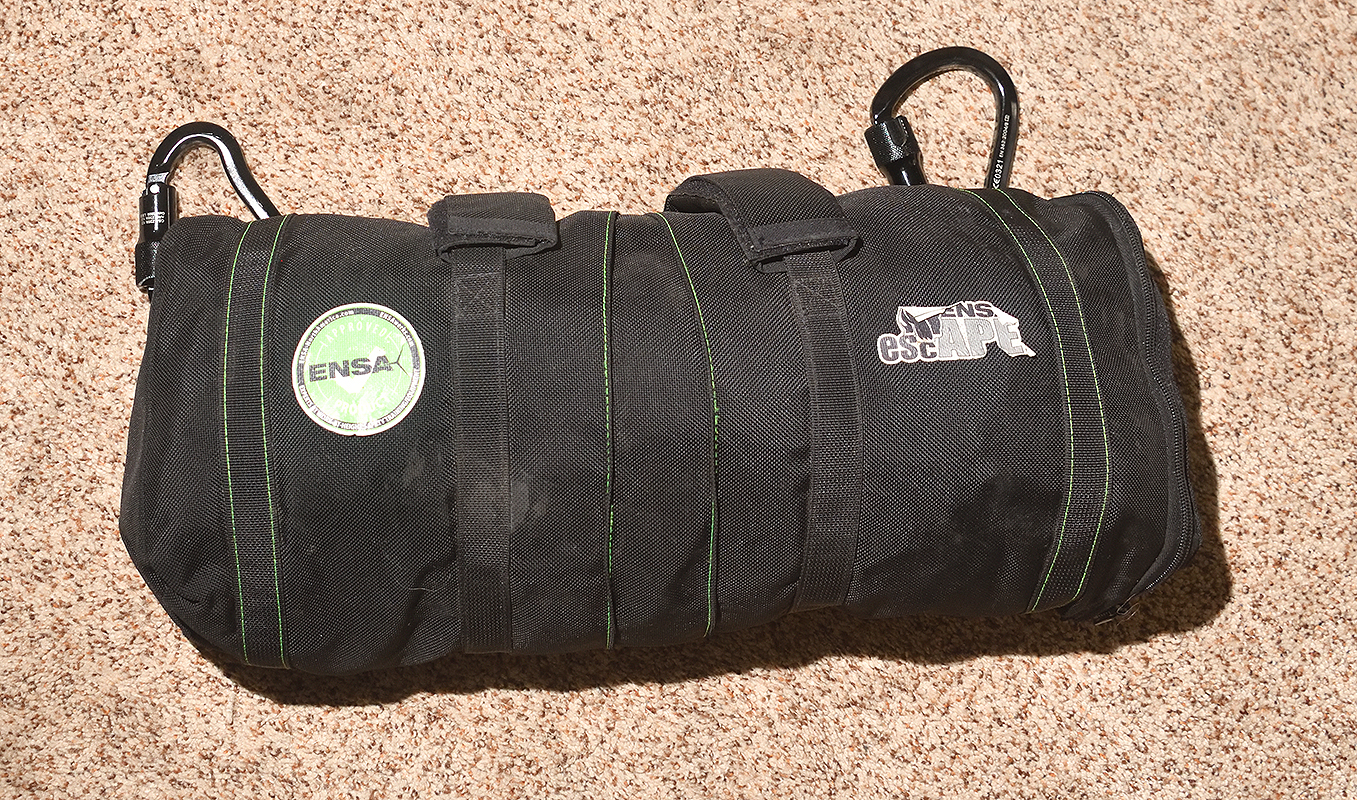Technical Details
I acquired an ENSA escAPE kit from Brian M. Burasco in 2023 and a lone descender from Jeremy Kluesner later that same year.
My ENSA escAPE is 156 mm. tall, 116 mm. wide, 40 mm. thick, and weighs 248 g.
The escAPE consists of a pivoting bollard and three fixed pins between two 3.2 mm. plates. The pins are 26 mm. long and 9.3 mm. in diameter, and are attached to the plates by security socket-head cap screws. The plates have inward dog-leg bends so that they touch at the bottom, about a third of the way up the eyes. The eyes are 31.5 mm. high and 15.8 mm. wide. The eyes are offset toward the rear plate.
The rope follows a 540° path around the pivoting bollard. This bollard has a central divide along its bottom half, separating the rope path to keep the rope from crossing itself. The bollard pivots on a hidden axle fastened between the plates by security socket-head cap screws similar to the others. The bollard pivots over a small range of about 20°.
A handle with a locking latch pivots on the left-hand pin. With the handle in the up position, it an arm rotates the bollard clockwise, pressing the rope against the right-hand pin. Pulling the handle down releases this pressure and allows the rope to slide. Pulling further causes a nose on the handle to press the rope against the bollard, increasing friction.
My escAPE came as part of a kit that also included 122m of 8 mm. poly/nylon rope, four auto-locking carabiners, and a carry/storage bag.
The rear of the escAPE is printed with an image of the back of an ape's fist, "Patent Pending," "an ape logo with "ENSA escAPE," "3600 mbs.," "Max user wt.," "SWL 310lbs.," a book icon (not a book-with-an-"i"), "Read User Manual," "200224," "3449," "ANSI Z359.4-2013 Certified," and "NFPA 1983 2014 (e)."
The front of the escAPE is printed with an image of the front of an ape's fist, a logo with "MADE IN USA," a rigging illustration consisting of two curved rope segments with an anchor icon above the left one and a hand icon above the right, a socket wrench icon, and "8mm ENSA APE Escape Rope."
The ENSA escAPE kit is designed for emergency evacuation, and has features that make it undesirable for normal caving and climbing situations. There is no easy way to rig and derig the escAPE without taking it apart, and this requires special tools. Back-feeding 122 m. of soft rope is not a practical way to move the escAPE back to the top for another rappel. Attaching a second escAPE for a second rappeller is cumbersome because of the need for such tools.
The rope in the kit is quite soft and maddening to work with. I spent 45 incredibly frustrating minutes untangling the giant spontaneous knot inside the carry bag. This was one of the worst tangles that I've faced in ages. Had I needed to do this in an emergency, the results could have been tragic.
Like most descenders that have double-stop mechanisms, the double-stop design has to be carefully matched to the user's weight and the rope being used. If the rope is too large or the user too light, descending will require hand-feeding. If the rope is too small, there will be a range of handle positions between the two stopping extremes that will not provide adequate friction.
Aside from the rope tangles, these features may be tolerated in an emergency descender intended for one-time use, but they make it inappropriate for my needs.



